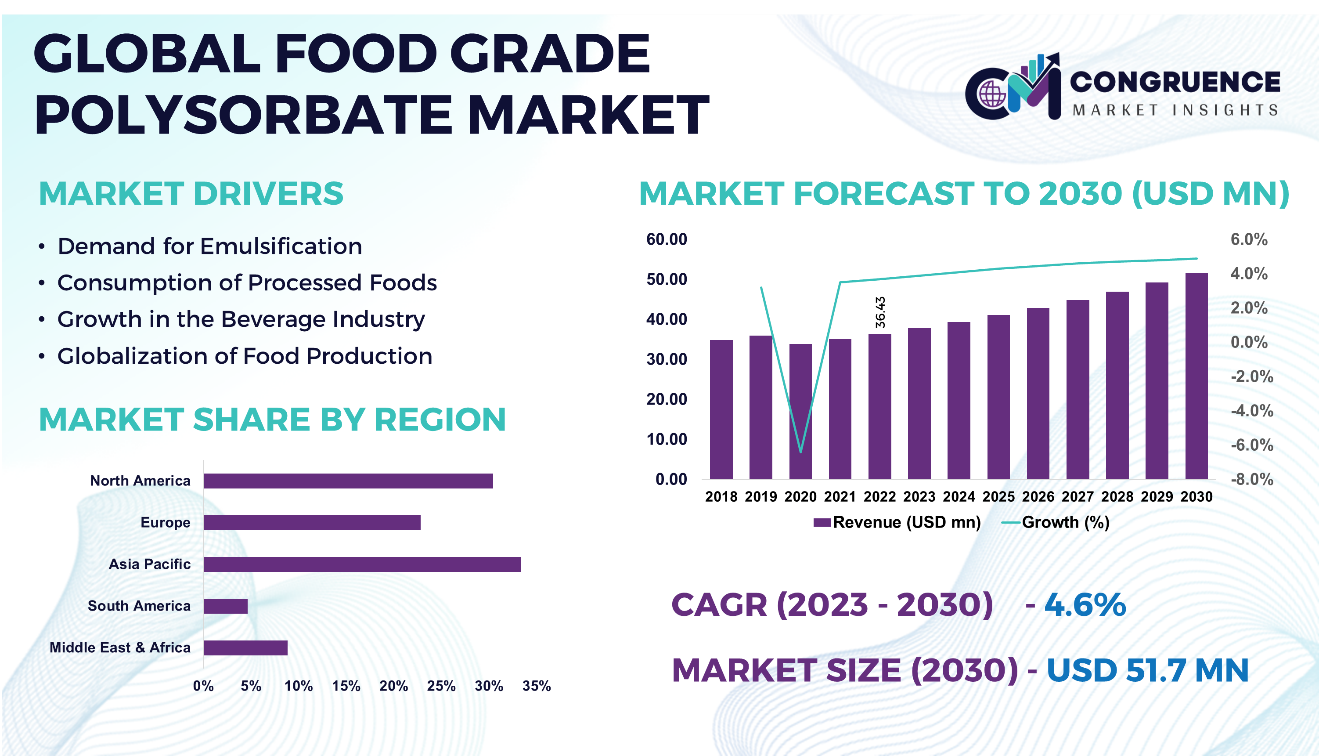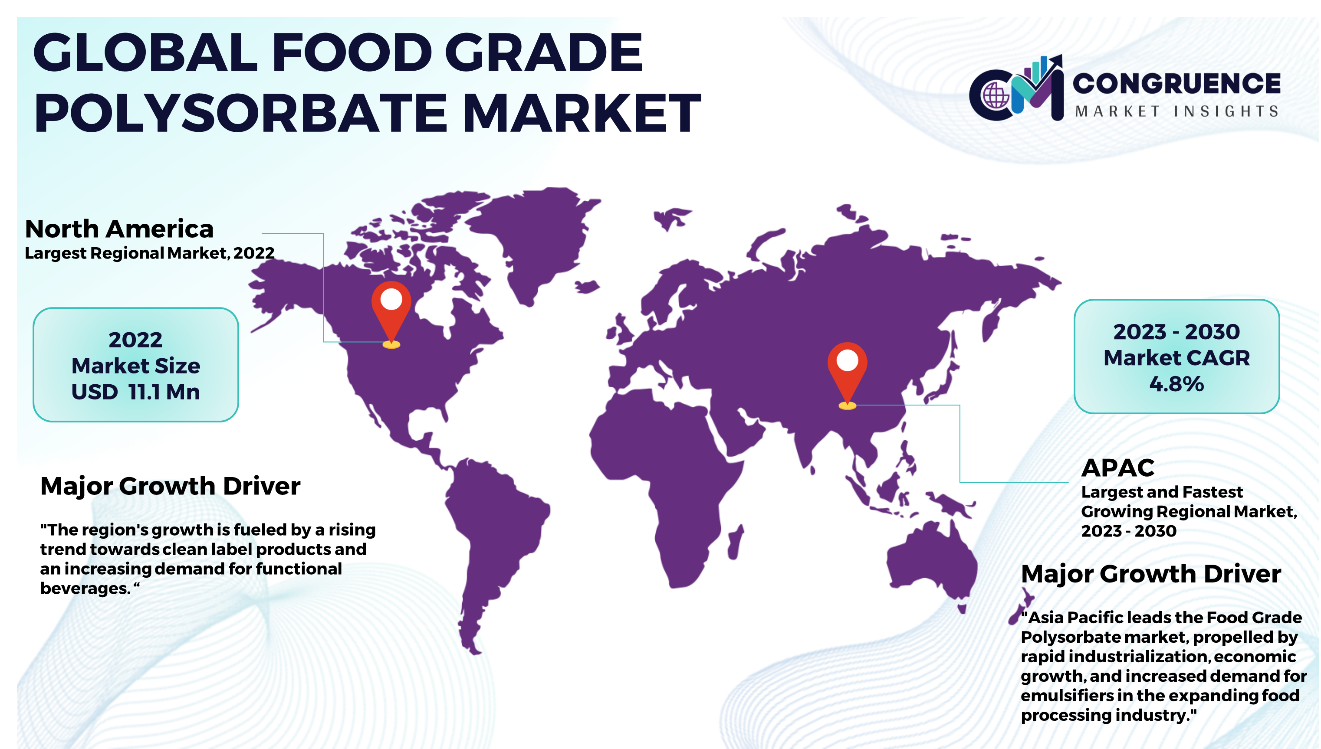Reports
The Global Food Grade Polysorbate market was valued at USD 36.4 Million in 2022 and is anticipated to reach a value of USD 51.7 Million by 2030 expanding at a CAGR of 4.6% between 2023 and 2030.
The global food industry has experienced a substantial transformation through the widespread incorporation of food-grade polysorbates. Tailored specifically for food applications, polysorbates have emerged as essential additives, reshaping the integration of ingredients in diverse food and beverage products. Renowned for their outstanding emulsifying properties, the range of food-grade polysorbates, encompassing Polysorbate 20, Polysorbate 40, Polysorbate 60, and Polysorbate 80, functions as vital stabilizers, ensuring consistency and quality across an extensive range of food formulations. This adaptability has established them as indispensable elements in baked goods, dairy products, beverages, dressings, and confectionery manufacturing processes.
A distinctive attribute of food-grade polysorbates lies in their proficiency in emulsification. They excel in creating and sustaining homogeneous mixtures, a crucial function for achieving desired textures and mouthfeel in various food products. The stabilizing effect of polysorbates proves particularly valuable in applications such as ice cream, whipped toppings, and dressings, contributing significantly to these food items' overall quality and sensory experience. Notably, in the beverage industry, Polysorbate 20 assumes a pivotal role, facilitating the solubilization and emulsification of flavors and ingredients across a diverse array of beverages.

Food Grade Polysorbate Market Major Driving Forces
Demand for Emulsification: The surging need for emulsifying agents in the production of food and beverages stands out as a significant driving factor. Food Grade Polysorbates, such as Polysorbate 20 and Polysorbate 80, are acknowledged for their exceptional emulsification properties, facilitating the consistent amalgamation of ingredients and elevating the overall quality of various products.
Consumption of Processed Foods: The increasing global consumption of processed and convenience foods emerges as a pivotal factor shaping the demand for Food Grade Polysorbates. These additives play a crucial role in stabilizing and enhancing the texture of processed foods, contributing to their prolonged shelf life and improved sensory attributes.
Growth in the Beverage Industry: The expansion of the beverage industry, particularly the rising demand for flavored and functional beverages, contributes significantly to the increased utilization of Polysorbates. Notably, Polysorbate 20 finds widespread use in solubilizing and emulsifying flavors and ingredients in various beverage formulations.
Globalization of Food Production: The globalization of food production and the widening scope of international food markets propel the necessity for versatile emulsifiers like Food Grade Polysorbates. They empower manufacturers to craft uniform and high-quality products that adhere to global standards.
Food Grade Polysorbate Market Key Opportunities
Eco-Friendly and Sustainable Options: The increasing demand for eco-friendly products presents an opportunity for the Food Grade Polysorbate market to develop and promote sustainable options. Manufacturers can capitalize on this trend by using recycled and organic materials or offering Food Grade Polysorbates with responsible sourcing and production.
Online Retail and E-commerce Growth: The continued growth of online retail and e-commerce platforms provides an opportunity for Food Grade Polysorbate manufacturers to expand their reach and tap into a broader customer base. Online sales channels allow for easier product accessibility and global market penetration.
Customization and Personalization: Consumers increasingly seek personalized and unique bedding solutions. Food Grade Polysorbate manufacturers can offer customization options, allowing customers to choose materials, sizes, and designs tailored to their preferences. This trend enhances customer engagement and brand loyalty, creating opportunities for premium and niche markets.
Food Grade Polysorbate Market Key Trends
· The food industry is experiencing a growing preference for clean-label and natural products. This trend underscores a heightened demand for Food Grade Polysorbates, recognized as emulsifiers seamlessly aligning with clean label preferences.
· The functional beverage market is swiftly expanding, and within this dynamic landscape, Food Grade Polysorbates, especially Polysorbate 20, are assuming a pivotal role in solubilizing and emulsifying flavors. The surge in innovations within the functional beverage sector is propelling the widespread adoption of these emulsifiers.
· Food-grade polysorbates are contributing to the production of these healthier options by providing essential emulsification and stabilization in various health-oriented food items.
· Food-grade polysorbates are undergoing a trend of tailored applications in the food industry, particularly in segments such as confectionery, bakery, and dairy products.
· Ongoing technological advancements in emulsification processes are influencing the evolution of Food Grade Polysorbates.
· The globalization of food production and supply chains is exerting influence on the standardization of food products. Food-grade polysorbates, with their capacity to ensure consistency and quality, are becoming integral components in achieving standardized products tailored to meet global market demands.
Region-wise Market Insights
Asia Pacific accounted for the largest market share at 33.4% in 2022 and is noticing the fastest growth rate at a CAGR of 4.8% whereas, North America is expected to register the second fastest growth, expanding at a CAGR of 4.6% between 2023 and 2030.

The global market for food-grade polysorbates exhibits dynamic trends influenced by regional factors across different continents. In North America, a well-established food and beverage sector places emphasis on clean-label products and natural ingredients, fostering a steady demand for food-grade polysorbates. Europe, known for its discerning consumer base and stringent food regulations, experiences a growing market driven by the increasing popularity of natural and organic options. The Asia-Pacific region, particularly in countries like China and India, witnesses substantial growth due to a rising population, evolving dietary preferences, and a burgeoning demand for processed foods. In Latin America, economic factors and a shift towards convenience foods contribute to the market's dynamics. The Middle East and Africa, shaped by climate conditions and infrastructure development, showcase unique market trends. Globally, overarching themes such as the demand for clean-label products, the rise of functional foods, and the globalization of food supply chains drive the use of food-grade polysorbates. These trends, coupled with innovations in food processing technologies and a heightened focus on sustainability, collectively shape the market's trajectory on a global scale.
Segment-wise Market Analysis
· Polysorbate 80 tends to be the largest segment in the Food Grade Polysorbate market. Polysorbate 80 dominates the Food Grade Polysorbate market due to its versatile emulsifying properties, making it a preferred choice across various food applications.
· Food and food product producers hold the largest share in the global Food-Grade Polysorbate market as key end-users. They extensively utilize these emulsifiers in diverse applications, including confectionery, bakery, dairy, and beverages, benefiting from their essential emulsification and stabilization properties.
Market Competition Landscape
The global food-grade polysorbate market is characterized by robust competition among key players striving to establish their market presence. Major companies are actively engaged in research and development to innovate and enhance their product portfolios. These companies focus on delivering high-quality food-grade polysorbates that meet evolving consumer demands for clean-label products and natural ingredients. Strategic partnerships, collaborations, and acquisitions are prominent strategies employed by key players to strengthen their market position and expand their geographical reach. Additionally, continuous efforts in marketing and branding initiatives help companies differentiate their offerings and establish a strong market presence. As the demand for food-grade polysorbates continues to rise, competition remains intense, prompting companies to invest in technological advancements and sustainable practices to stay competitive in this dynamic market landscape. Consumer preferences for healthier food options, adherence to stringent regulatory standards, and the growing significance of clean label trends collectively contribute to the competitive dynamics of the global food-grade polysorbate market.
Key players in the global food grade polysorbate market implement various organic and inorganic strategies to strengthen and improve their market positioning. Prominent players in the market include:
· UL LLC
· Croda International Plc
· Kao Corporation
· SEPPIC
· Oleon NV (Avril)
· Guangdong Huana Chemistry Co., Ltd.
· SPAK Orgochem Pvt. Ltd.
· Kerry Group plc
· Hawkins Watts Limited
· Palsgaard
· Others
|
Report Attribute/Metric |
Details |
|
Market Revenue in 2022 |
USD 36.4.0 Million |
|
Market Revenue in 2030 |
USD 51.7 Million |
|
CAGR (2023 – 2030) |
4.6% |
|
Base Year |
2022 |
|
Forecast Period |
2023 – 2030 |
|
Historical Data |
2018 to 2022 |
|
Forecast Unit |
Value (US$ Mn) |
|
Key Report Deliverable |
Revenue Forecast, Growth Trends, Market Dynamics, Segmental Overview, Regional and Country-wise Analysis, Competition Landscape |
|
Segments Covered |
· By Polysorbate Type (20, 40, 60, and 80) · By Application (Confectionery, Dairy Products, Beverages, Dressings and Sauces, and Others) · By End User (Food and Food Products Producers, Beverage Producers, Culinary Professionals and Home Bakers, and Others) · By Sales Channel (Online Stores, and Offline Stores) |
|
Geographies Covered |
North America: U.S., Canada and Mexico Europe: Germany, France, U.K., Italy, Spain, and Rest of Europe Asia Pacific: China, India, Japan, South Korea, Southeast Asia, and Rest of Asia Pacific South America: Brazil, Argentina, and Rest of Latin America Middle East & Africa: GCC Countries, South Africa, and Rest of Middle East & Africa |
|
Key Players Analyzed |
UL LLC, Croda International Plc, Kao Corporation, SEPPIC, Oleon NV (Avril), Guangdong Huana Chemistry Co., Ltd., SPAK Orgochem Pvt. Ltd., Kerry Group plc, Hawkins Watts Limited, Palsgaard, and Othersade Polysorbate, Brook + Wilde, and The WoolRoom Deluxe |
|
Customization & Pricing |
Available on Request (10% Customization is Free) |
